Road Test – Head turner
The king of manoeuvrability, Scania’s tri-axle 13.2-metre Irizar i6S has gained some high-profile sales. We took a spin in one of a pair for Leons to see why operators have chosen this 53-seater
The popularity of near-13-metre, two-axle touring coaches with 53/57 seats has been a feature of buying patterns in the last five years.
For most coach operators, it seems, that’s an ideal capacity and length, and most marques now have a vehicle of the type in this highly competitive sector. However, two-axle, high-capacity coaches are always going to run the gauntlet of being overweight when fully-loaded with some tour groups.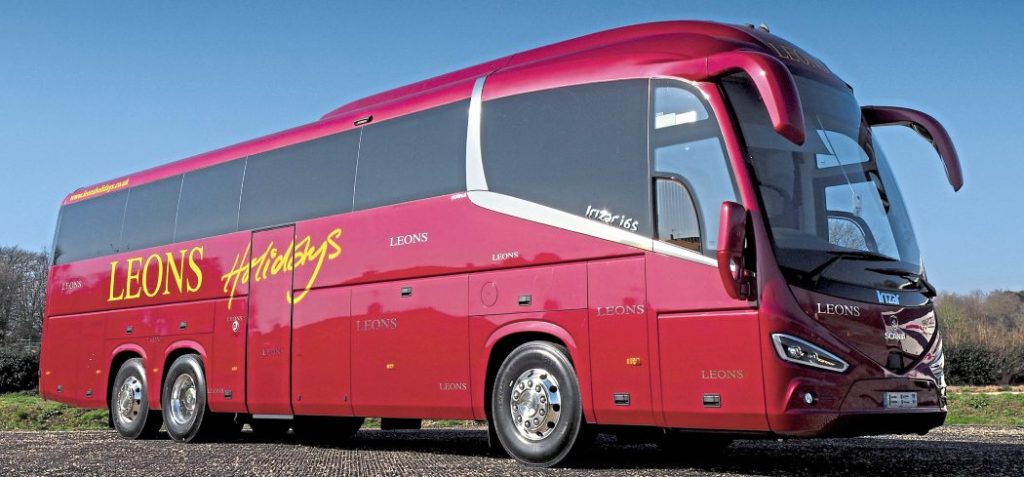 Tri-axles aren’t to everyone’s taste but are the complete insurance against overloading and though they come with the downside of extra tyres to buy, with rear-steer, they also have the upside of astonishing manoeuvrability. Our road test driver found this out as we left the Scania Bus and Coach HQ in Worksop.
Tri-axles aren’t to everyone’s taste but are the complete insurance against overloading and though they come with the downside of extra tyres to buy, with rear-steer, they also have the upside of astonishing manoeuvrability. Our road test driver found this out as we left the Scania Bus and Coach HQ in Worksop.
The coach on test is one of two super-high tri-axle 13.22-metre Irizar i6Ss for Leons, straight from the factory with the Stafford operator’s stunning livery. It’s a popular configuration.
Andy Douglas at Leons Coaches said the Irizars were a direct replacement for their much-loved Starliners: “Now there are no Starliners, they’re the next best thing, mainly for being the best-looking coaches with the ‘wow’ factor we want.
“They’re the first Scanias we’ve had for two years, I think.”
Exterior
Irizar’s i6 bodywork is well established in the market, and lauded by many for the ‘wow’ factor of its kerbside appeal.The i6 is not a coach,  but a range of coaches from 10.8 metres right up to 15 metres, all sharing the sweeping, stylish curved style with the signature roof bump which has its origins in the then-groundbreaking Irizar PB. It has crept over now into the premium i8 coach range, which has clear signs of being from the same family. Lee Wale at Scania says the i6S is now the only option for tri-axle Irizars, and B&CB suspects that the rest of the model range will migrate to this specification in time.
but a range of coaches from 10.8 metres right up to 15 metres, all sharing the sweeping, stylish curved style with the signature roof bump which has its origins in the then-groundbreaking Irizar PB. It has crept over now into the premium i8 coach range, which has clear signs of being from the same family. Lee Wale at Scania says the i6S is now the only option for tri-axle Irizars, and B&CB suspects that the rest of the model range will migrate to this specification in time.
The Spanish coachbuilder has grown massively from the early days of the PB, with a factory which is a stylish as the coaches. Strong exterior designs which depart from the norm will always polarise opinion, but what is not in doubt these days is the quality of Irizar products, and this is reflected in the road test vehicle.
It would be pointless to describe the i6, panel by panel, but a close inspection revealed neat, even shut gaps and accomplished detailing, together with impressive paintwork from the factory. This super-high version of i6S is all about locker space, with powered main locker doors, then four more access doors on the nearside, and five on the offside, some providing useful cubby holes. That said, the near-13m3 of luggage bay is more than adequate for the maximum 53 passengers.
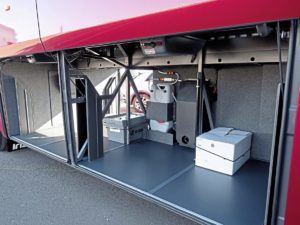 The luggage bay houses the freshwater tank but, apart from this, is a tidy, clear space. The small locker directly over the rear axle on the nearside houses the batteries. One next to it is ideal for the driver’s luggage.
The luggage bay houses the freshwater tank but, apart from this, is a tidy, clear space. The small locker directly over the rear axle on the nearside houses the batteries. One next to it is ideal for the driver’s luggage.
A good look into the engine bay reveals tidily fitted electrics. Our test driver also noted the cavernous space between the transmission and coach floor; it’s a favoured hiding place for migrants trying to smuggle themselves into the UK, so worth showing drivers on cross-Channel work and perhaps worthy of fitment of a CCTV camera.
AdBlue is filled from the offside rear, and the fuel tank has fillers on both sides of the coach over the front axle.
The main passenger door opens on to a very good stairwell with courier seat to the right and handrails both sides. Similarly, the ‘continental door’ on the offside, which has fairly steep but very usable stairs.
Interior
Entering the i6S from the 900mm passenger door, the exuberance of design is clear from the start; even the stairs themselves feature styling, with dotted nosings.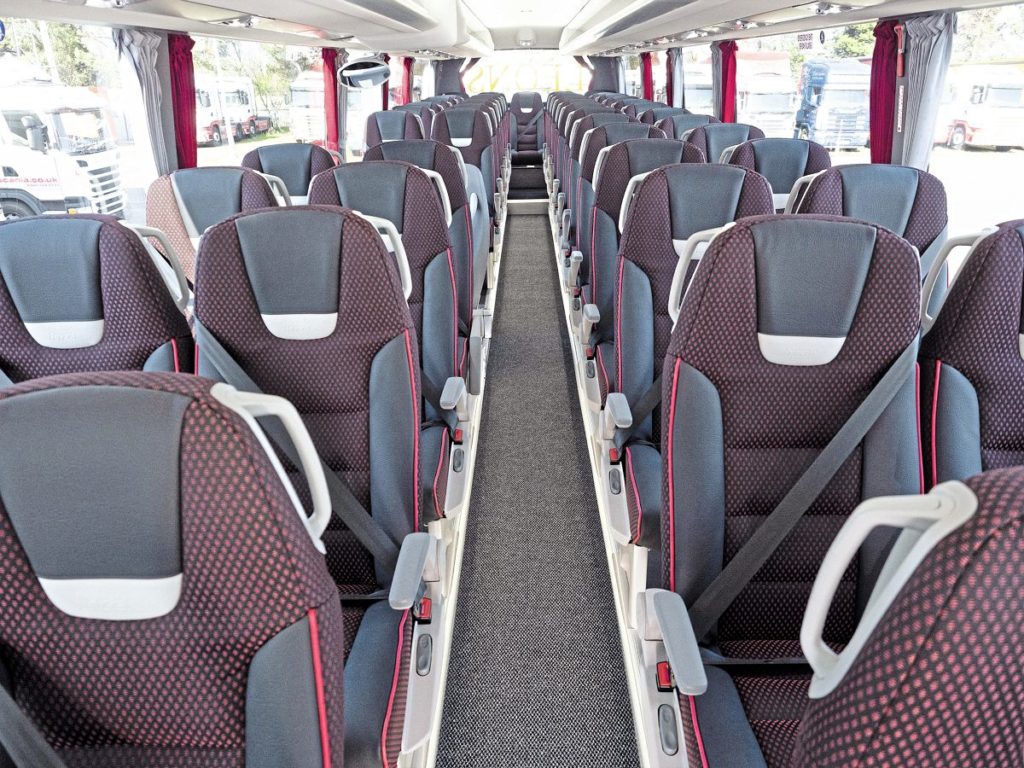 The light grey plastics which keep the interior bright are evident everywhere, together with lovely touches. For example, the brackets holding the decency screen to the floor are stylish cast alloy creations, not the usual painted steel.
The light grey plastics which keep the interior bright are evident everywhere, together with lovely touches. For example, the brackets holding the decency screen to the floor are stylish cast alloy creations, not the usual painted steel.
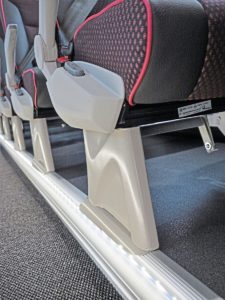 The aisle edgings of most coaches are simple panels, but Irizar has installed sculpted alloy extrusions. Throughout the coach, you will find car-quality mouldings, and capped or plated fasteners. If the devil is in the detail, this coach should have horns and a spear-ended tail.
The aisle edgings of most coaches are simple panels, but Irizar has installed sculpted alloy extrusions. Throughout the coach, you will find car-quality mouldings, and capped or plated fasteners. If the devil is in the detail, this coach should have horns and a spear-ended tail.
The Irizar i6S seats feature leather-look inlays and a flat-weave fabric in a red-flacked blue-grey, with red piping and leather-look bolsters. In this coach, they aren’t side-shift seats but have recline and very interesting footrests; the test driver (who runs Irizars) pointed out that they have two positions, and can either be flipped back towards the short-legged passenger, or flipped forward under the seat in front for a longer-legged passenger.
While at floor level, the full-length convector heaters are mounted above the floor itself, with no narrow gaps to trap debris.
Seat pitch on this variant is exceptional, as you’d expect. This makes the neat seatback tables, which have a sliding extension to create more space, entirely usable. Leons has decided not to have USB sockets but if specified, they are fitted between the seat squabs.
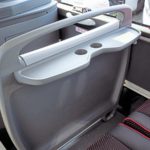 At the front, the TV monitors, clock, seatbelt warning sign and ‘toilet vacant’ sign sit within their own binnacle moulding with brightwork inlays. Below this, Leons has specified a Hanover destination board; not for express coach regulation but as an information board. A minor criticism of this is that it reduces forward view which, on this model, is already a little restricted by the design.
At the front, the TV monitors, clock, seatbelt warning sign and ‘toilet vacant’ sign sit within their own binnacle moulding with brightwork inlays. Below this, Leons has specified a Hanover destination board; not for express coach regulation but as an information board. A minor criticism of this is that it reduces forward view which, on this model, is already a little restricted by the design.
Above the seats, the luggage racks are capacious, with LED mood lighting on the upper edge. At the front, there are two lockable lockers. The first aid kit is installed behind the driver’s seat, so these are both available for valuables and documentation.
 The passenger service units installed under the racks have ventilation, reading lights, ‘stop’ and service buttons. At the end of the offside front rack, the second TV monitor is fitted, again with its own moulding to keep it tidy.
The passenger service units installed under the racks have ventilation, reading lights, ‘stop’ and service buttons. At the end of the offside front rack, the second TV monitor is fitted, again with its own moulding to keep it tidy.
The coach has a toilet mounted in the offside stairwell with sprung-closed door. Above it, a simple drinks boiler and servery unit is installed. Typically, all of the fasteners for this unit are plastic-capped for neatness.
Driving
The core feature of all i6S models is the introduction of multiplex wiring which, beneath the skin, avoids complex looms which are hard to fault-trace.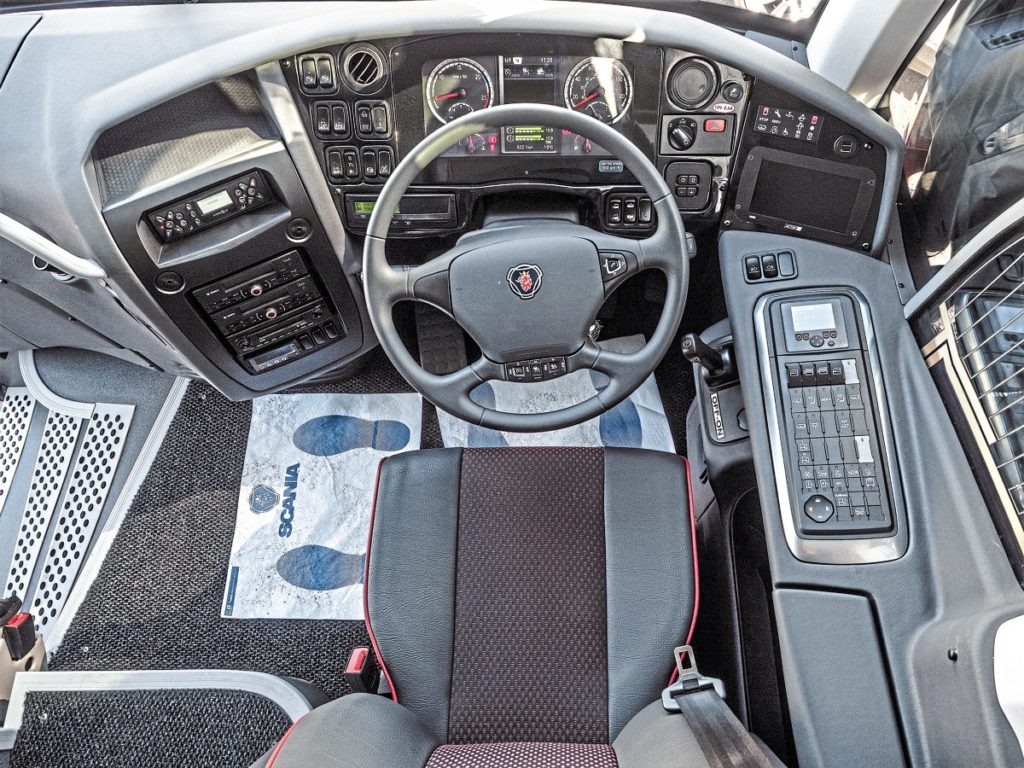 This manifests itself, to some extent, in the driver area, where the dashboard is notably different from the coach’s predecessors. The central instrument cluster includes tachometer and speedometer, fuel and temperature gauges either side of a multifunction LCD display which can be set to display a variety of information including, permanently, the Tyre Pressure Monitoring System (TPMS).
This manifests itself, to some extent, in the driver area, where the dashboard is notably different from the coach’s predecessors. The central instrument cluster includes tachometer and speedometer, fuel and temperature gauges either side of a multifunction LCD display which can be set to display a variety of information including, permanently, the Tyre Pressure Monitoring System (TPMS).
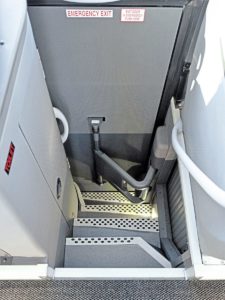 To the left of this is the core ‘chassis’ switchgear including cruise/adaptive cruise on/off. System warning lights are in a cluster to the right of the steering wheel, and there are switches below this for the ferry lift and LDW system. On the steering wheel, the coach has the hands-free phone controls and the cruise controls.
To the left of this is the core ‘chassis’ switchgear including cruise/adaptive cruise on/off. System warning lights are in a cluster to the right of the steering wheel, and there are switches below this for the ferry lift and LDW system. On the steering wheel, the coach has the hands-free phone controls and the cruise controls.
To the driver’s right are all the saloon lighting and comfort controls, locker door release and fuel/AdBlue flap release. The small, additional LCD screen chiefly adds a diagnostics function but, as the hugely knowledgeable Steve Dunk pointed out, little of any use to the driver.
The driver has a storage pocket which will take a water bottle and a document locker. The cup holder is mounted on the A pillar. On some coaches, this would be a stretch, but not on the i6S.
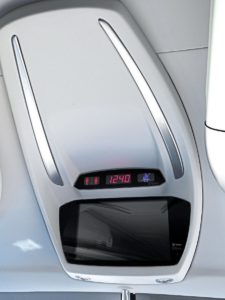 The test driver’s first remark was how good the seating position is; the driver is sitting well forward, with an excellent view, yet the seat has plenty of space for rearward adjustment; the cup holder is within easy reach. The Bosch media system is to the left, together with the Hispacold air-con controls above and Hanover display controls below.
The test driver’s first remark was how good the seating position is; the driver is sitting well forward, with an excellent view, yet the seat has plenty of space for rearward adjustment; the cup holder is within easy reach. The Bosch media system is to the left, together with the Hispacold air-con controls above and Hanover display controls below.
It’s a nicely designed dashboard in most ergonomic senses apart from one; the driver’s view of the speedometer is significantly obscured by the steering wheel. Our test driver tried several steering wheel positions to alleviate this, but with only partial success.
The forward mirror units have shorter arms than earlier incarnations of the i6. This created another minor problem; a part of the mirror view is not within the swept area of the wiper blades, so a grubby windscreen or heavy rain would reduce the rear view. That said, the waist-level driver mirror was excellent and would compensate.
The driver has a heated electric window and twin electric window blinds, a microphone (there’s another and a map light for the courier).
After familiarising himself with the dash, the test driver left the Scania HQ, immediately noting the impressive turning circle and manoeuvrability of this coach; it effortlessly coped with tight turns and had the all-round visibility to use this advantage. In numbers, the tri-axle has a turning circle around 1 metre smaller than its equivalent in two-axle but it feels less, perhaps due to the shorter rear overhang.
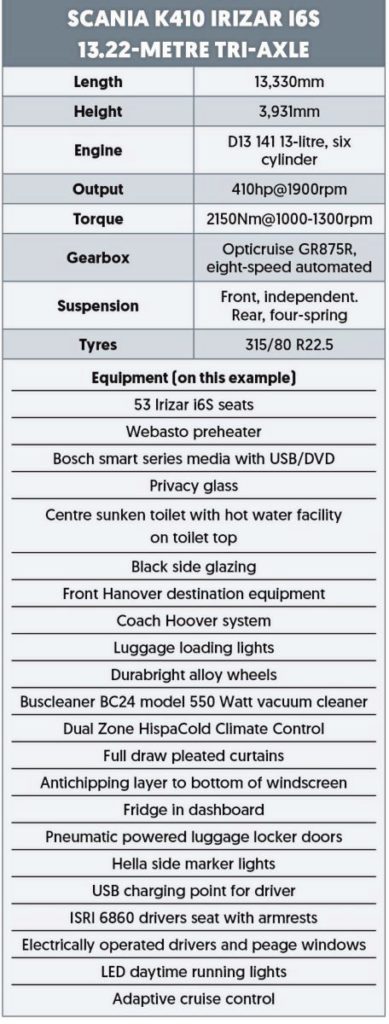 Leon’s coach has the 410bhp DC13 engine coupled with an eight-speed Opticruise automated gearbox. It has a hydraulic retarder in the driveline. The combination gave nicely-controlled acceleration with little hesitancy between gear up-changes and more than adequately built up speed.
Leon’s coach has the 410bhp DC13 engine coupled with an eight-speed Opticruise automated gearbox. It has a hydraulic retarder in the driveline. The combination gave nicely-controlled acceleration with little hesitancy between gear up-changes and more than adequately built up speed.
Braking, said the test driver, was exceptional; progressive and easily controlled to avoid lurching. The throttle control was nicely muted – a feature the driver liked. Sensitive throttles are a recipe for passenger discomfort so this set-up, which needed big throttle inputs to achieve downshift or urgency, was right on the money.
Overtaking and motorway cruising was effortless and the ride was firm and felt nicely controlled, with no pitching. Steering inputs got a positive and predictable reaction. The test driver thought the ride over potholed surfaces was a little firm with the bumps transmitted to the interior. That said, this did not detract significantly from the passenger ride.
On the limiter, the tachometer was showing 1,400rpm. The Opticruise gearbox makes ‘intelligent’ selections and will automatically detect uphill sections which may be more economically tackled in a lower ratio. Radar from the Adaptive Cruise Control is also used to match the selected ratio to the vehicle in front, for best economy. Although the gearbox has a ‘manual’ gear selection, it will only allow the selection of a usable ratio, and in its Power mode, will override unnecessary use. It has Hill Hold, naturally.
As with all modern coaches, the i6S has Lane Departure Warning. That fitted to this Scania was exceptional; never over-sensitive and giving false warnings, and with a right/left seat vibration to alert the driver to the direction of drift. We also tested the adaptive cruise control, which has five distance following settings; it worked perfectly. We thankfully did not have occasion to test the Emergency Brake Assist but Steve Dunk told us it has four escalating stages beginning with a driver warning and ending in full braking to a standstill.
As a passenger on this test, I had the opportunity to take in the saloon ambience. Although road and mechanical noise were absent forward of the continental door, around the centre door and towards the rear, there was evidence of transmission whine and, at the back, a low-frequency noise. Neither were uncomfortably loud, and a little music on the radio or passenger chat would probably drown them out.
In every respect, passengers are well catered for. The i6S seats were very comfortable – I understand Leons specified extra padding – and the general ambience was excellent. It was a bright day when we tested the coach, and the privacy glazing was appropriate. Thankfully, the i6S is a roomy, bright coach generally, so even on a dull day, it shouldn’t get claustrophobic.
Verdict
This configuration of a well-established and respected coach like the i6 comes with some advantages.
As we said straight away, the tri-axle chassis gives total peace of mind about overloading, but much more besides. The vehicle’s rail-like stability on the motorway was admirable, and its maneouvres around country roads, in the Sherwood Forest coach park where the main photo was taken, and at Scania Bus and Coach really highlighted how far tri-axles have come.
The 13-litre DC13 engine, which has SCR only to achieve Euro VI, is torquey and responsive, the gearbox quirkiness explained by how cleverly it makes good use of engine efficiency with its terrain response controls. Our test driver wasn’t phased by a dashboard which is easy to interpret, the switchgear logically laid out and within comfortable reach.
Enough has been written about the Irizar i6S bodywork already; we’re fans, and not just for the kerb appeal, but for the attention to detail the Spanish coachbuilder devotes to the design.
Marking the coach down for anything is tricky, but the position of the front mirrors outside of the swept area of the wipers, and the way the steering wheel hides the speedometer dial are definite niggles. As for your customers, they’ll notice none of this; Leon’s has bought itself two crowd-pleasers.
Supplier:
Scania (Great Britain), Claylands Avenue, Worksop, S81 7DJ.
Tel: 01909 500822
Website: